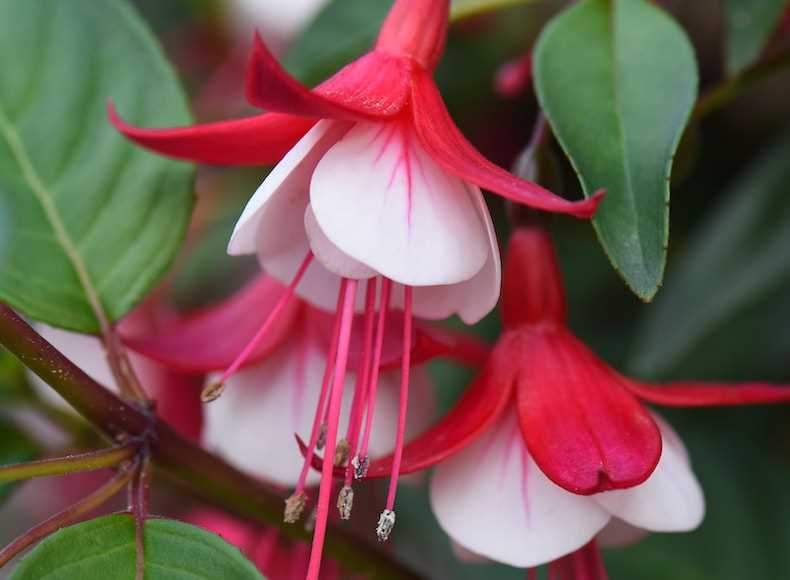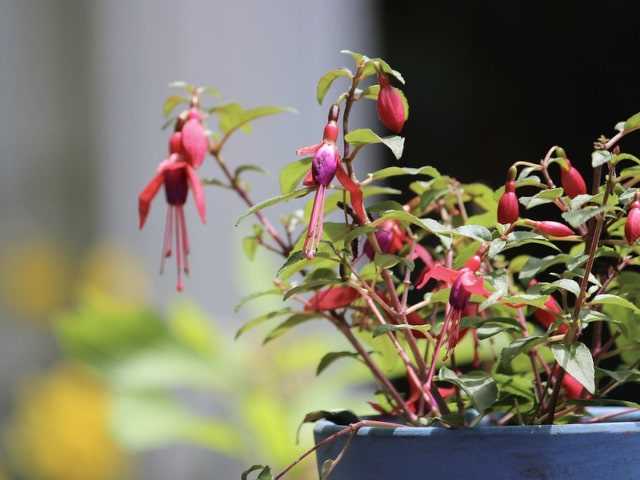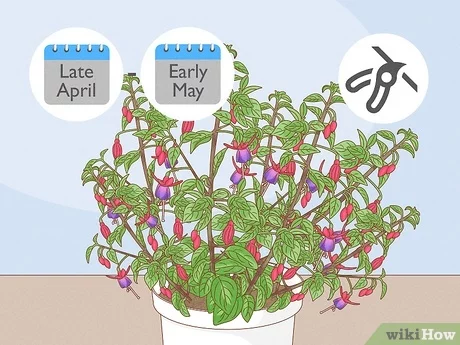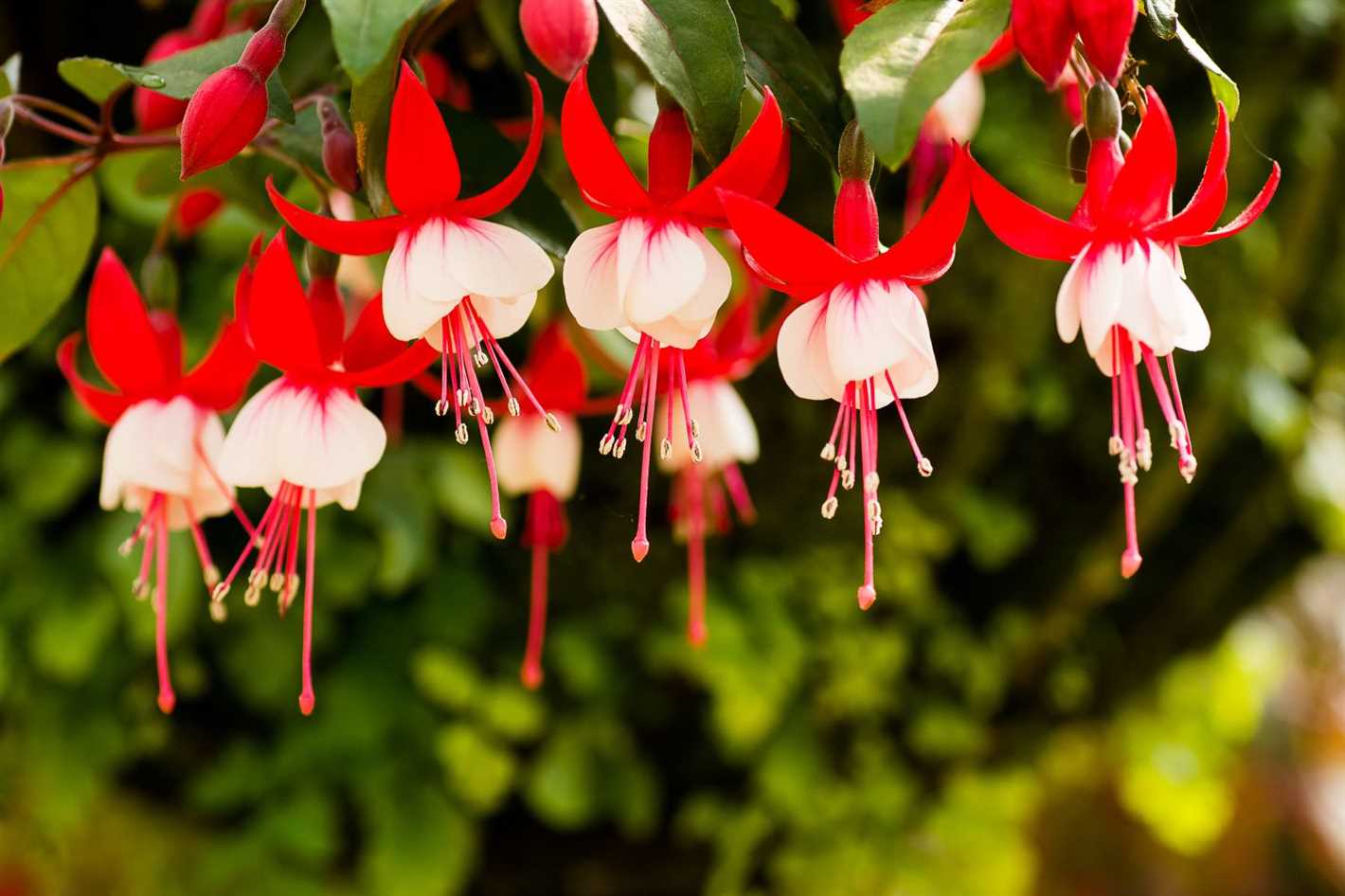- The Benefits of Pruned Petioles and Leaves for Propagating Fuchsia
- 1. Increased Success Rate
- 2. Cost-Effective
- 3. Quick and Easy
- 4. Genetic Preservation
- 5. Versatility
- The Importance of Pruning for Propagation Success
- 1. Stimulating New Growth
- 2. Increasing Branching
- 3. Removing Weak or Diseased Material
- 4. Promoting Air Circulation
- 5. Encouraging Flowering
- The Best Time to Prune Fuchsia Plants
- Choosing the Right Petioles for Propagation
- 1. Freshness
- 2. Size
- 3. Leaf Attachment
- 4. Disease-free
- 5. Variety
- Step-by-Step Guide to Propagating Fuchsia with Pruned Petioles
- Using Pruned Leaves for Fuchsia Propagation
- Materials Needed
- Steps to Propagate Fuchsia Using Pruned Leaves
- Tips and Considerations
- Tips for Successful Fuchsia Propagation with Pruned Petioles and Leaves
- 1. Choose healthy and well-established plants:
- 2. Timing is key:
- 3. Prepare the cuttings:
- 4. Use a suitable rooting medium:
- 5. Provide the right environment:
- 6. Keep an eye on moisture levels:
- 7. Patience is key:
- Q&A:
- What is the best method for propagating Fuchsia?
- Can I propagate Fuchsia using other methods?
- How do I propagate Fuchsia using pruned petioles and leaves?
- Why is using pruned petioles and leaves the best method for propagating Fuchsia?
- How long does it take for the pruned petioles and leaves to root?
- Video: How to Prune Fuchsias by The Gardening Tutor-Mary Frost
Fuchsia plants are known for their vibrant and beautiful flowers, making them a popular choice for gardeners and plant enthusiasts alike. One of the best ways to propagate fuchsia is by using pruned petioles and leaves, as this method has been proven to be effective and successful.
Pruned petioles are the stalks that connect the leaves to the stem of the plant. By taking a healthy petiole and cutting it at a 45-degree angle, you can create a cutting that is ready for propagation. It is important to make sure that the petiole is free from any diseases or pests, as this can affect the success of the propagation.
Once you have your pruned petiole, you can dip the cut end in a rooting hormone to encourage root growth. Then, place the cutting in a well-draining soil mix or perlite and keep it in a warm and humid environment. Regular misting is important to ensure that the cutting does not dry out. Over time, the petiole will develop roots and can be planted in a pot or in the garden.
Using pruned petioles is a great way to propagate fuchsia plants because it allows you to make use of the plant’s natural ability to grow new roots from the petioles. This method has been proven to be highly successful and reliable, making it a preferred choice for many gardeners.
In addition to pruned petioles, fuchsia leaves can also be used for propagation. By carefully removing a healthy leaf from the plant and making a small cut on the vein, you can create a cutting that is ready for propagation. Like with petioles, it is important to ensure that the leaf is free from any diseases or pests.
After making the cut on the vein of the leaf, you can dip the cut end in a rooting hormone and plant it in a well-draining soil mix or perlite. Again, keeping the cutting in a warm and humid environment and misting it regularly will help with root development. Once the leaf develops roots, it can be planted and grown into a new fuchsia plant.
Overall, using pruned petioles and leaves for propagating fuchsia plants is a reliable and effective method. It allows you to create new plants from existing ones, and with proper care and attention, these cuttings can develop into healthy and beautiful fuchsia plants that will brighten up any garden or green space.
The Benefits of Pruned Petioles and Leaves for Propagating Fuchsia
When it comes to propagating fuchsia, using pruned petioles and leaves can be highly beneficial. This method allows for the easy and efficient propagation of new plants, ensuring a successful and healthy growth cycle. Here are some of the key benefits of using pruned petioles and leaves:
1. Increased Success Rate
Using pruned petioles and leaves has been found to have a higher success rate compared to other propagation methods. This is because these plant parts already contain the necessary nutrients and hormones needed for successful root development. By providing the young plants with a ready supply of nutrients, they are more likely to establish strong root systems and thrive.
2. Cost-Effective
Propagating fuchsia using pruned petioles and leaves can be a cost-effective method. Instead of purchasing new plants or expensive propagation equipment, you can utilize the pruned parts from existing fuchsia plants. This not only saves money but also reduces waste.
3. Quick and Easy
The process of using pruned petioles and leaves is relatively simple and straightforward. It involves selecting healthy and mature leaves or petioles, preparing them for propagation, and providing the right conditions for root development. This method is ideal for both experienced and novice gardeners, as it doesn’t require specialized skills or equipment.
4. Genetic Preservation
Using pruned petioles and leaves allows for the preservation of the genetic characteristics of the parent plant. This is especially important if you have a specific fuchsia variety that you want to propagate and maintain. By using pruned parts from the parent plant, you can ensure that the new plants will have the same desirable traits.
5. Versatility
Pruned petioles and leaves can be used to propagate fuchsia through different methods, such as water propagation, soil propagation, or even tissue culture. This versatility allows for flexibility in propagation, enabling gardeners to choose the method that best suits their preferences and resources.
| Benefits | Explanation |
|---|---|
| Increased Success Rate | Pruned petioles and leaves already contain essential nutrients and hormones for root development, leading to higher success rates in propagation. |
| Cost-Effective | Utilizing pruned parts from existing plants saves money and reduces waste compared to purchasing new plants or specialized propagation equipment. |
| Quick and Easy | Using pruned petioles and leaves is a straightforward process that is suitable for both experienced and novice gardeners. |
| Genetic Preservation | By using pruned parts from the parent plant, the genetic characteristics of the desired fuchsia variety can be preserved in the new plants. |
| Versatility | Pruned petioles and leaves can be used for different propagation methods, providing flexibility to gardeners. |
The Importance of Pruning for Propagation Success
Pruning plays a crucial role in the successful propagation of fuchsia plants. By removing certain parts of the plant, such as petioles and leaves, gardeners can create ideal conditions for new growth and the development of healthy and vigorous fuchsia clones.
1. Stimulating New Growth
Pruning fuchsia plants triggers the growth of new shoots, which are essential for propagation. When certain parts of the plant are pruned, such as the tips of the stems or the apical buds, the plant responds by producing new shoots from the nodes below the cuts. These new shoots can then be used for propagation purposes.
2. Increasing Branching

Regular pruning encourages branching in fuchsia plants, creating a bushier and more compact growth habit. This increased branching provides more opportunities for the development of new shoots that can be utilized for propagation. Pruning also helps maintain the overall shape and appearance of the plant, resulting in healthier and more aesthetically pleasing specimens.
3. Removing Weak or Diseased Material
Pruning is an essential practice for removing weak, damaged, or diseased material from fuchsia plants. These parts can serve as entry points for pests and diseases, which can spread and harm the entire plant. By pruning these affected areas promptly, gardeners can prevent the spread of infections and maintain the overall health and vigor of the plant.
4. Promoting Air Circulation
Proper pruning techniques help to improve air circulation within the fuchsia plant. When excessive foliage is removed, air can flow more freely through the plant, reducing the risk of fungal diseases and promoting optimal growth conditions. Adequate air circulation also helps to prevent the accumulation of moisture, which can lead to rot and other problems.
5. Encouraging Flowering
Pruning can also play a role in promoting flowering in fuchsia plants. By selectively removing certain branches or shoots, gardeners can redirect the plant’s energy towards producing more flowers. This technique, known as de-budding, can result in a more prolific and colorful display of blooms.
In conclusion, pruning is an essential practice for successful propagation and overall plant health in fuchsia plants. By stimulating new growth, increasing branching, removing weak or diseased material, promoting air circulation, and encouraging flowering, proper pruning techniques can greatly contribute to the success and vitality of fuchsia plants.
The Best Time to Prune Fuchsia Plants
Pruning fuchsia plants is an essential task that helps maintain their health and improve their overall appearance. However, timing plays a crucial role in achieving successful pruning results.
1. Late Winter or Early Spring:
- Pruning fuchsia plants during late winter or early spring, before new growth emerges, is considered the best time.
- This period allows the plant to recover quickly and encourages vigorous growth during the upcoming growing season.
- It is important to avoid pruning when the temperatures are extremely low to prevent frost damage to the newly pruned branches.
2. After Flowering:
- You can also prune fuchsia plants after they have finished flowering.
- By removing spent flowers and cutting back any leggy or overgrown branches, you can promote better branching and more abundant blooms in the next season.
- It is recommended to wait until the threat of frost has passed before pruning after flowering.
3. Regular Maintenance Pruning:
- In addition to the above periods, you can perform regular maintenance pruning throughout the year to remove dead or damaged branches.
- Be cautious not to prune during extreme heat or severe drought conditions, as this can stress the plants.
Remember, proper pruning techniques are crucial to prevent the risk of disease and encourage healthy growth. Always use sharp and clean pruning tools and make clean cuts just above a leaf node or lateral branch.
Choosing the Right Petioles for Propagation
When propagating fuchsia using pruned petioles and leaves, it is important to choose the right petioles to ensure successful propagation. Petioles are the slender stalks that attach the leaves to the main stem of the plant. Here are some factors to consider when choosing the petioles:
1. Freshness
Choose petioles that are fresh and healthy. Avoid using petioles that are wilted, damaged, or discolored, as they may have a lower chance of successful propagation.
2. Size
Select petioles that are of moderate size. Petioles that are too small may lack sufficient energy and nutrients for successful rooting and growth. On the other hand, petioles that are too large may have a higher risk of rotting or fungal infection.
3. Leaf Attachment

Look for petioles that have a strong attachment to the leaf. Petioles that easily detach from the leaf may have a lower chance of successful propagation. Ideally, choose petioles with a short, intact section of the main stem attached.
4. Disease-free
Ensure that the petioles are free from any signs of disease or pest infestation. Using diseased petioles may spread the infection to the new plants and compromise their health.
5. Variety
If you have multiple fuchsia varieties, it is recommended to use petioles from the same variety for propagation. This will ensure that the new plants retain the characteristics and traits of the parent plant.
By considering these factors and selecting the right petioles, you can improve the chances of successful propagation and establish healthy new fuchsia plants.
Step-by-Step Guide to Propagating Fuchsia with Pruned Petioles
Propagating fuchsia plants using pruned petioles is a simple and effective method. Follow these step-by-step instructions to successfully propagate fuchsia plants.
- Gather Materials: Prepare the following materials before starting the propagation process:
- Sharp pruning shears
- Clean cutting board or surface
- Rooting hormone powder
- Potting soil mix
- Small pots or containers
- Clear plastic bags
- Watering can or spray bottle
- Select Healthy Fuchsia Plants: Choose healthy fuchsia plants that you want to propagate. Look for plants that have strong and vibrant foliage.
- Prune Petioles: Using sharp pruning shears, carefully prune several petioles from the selected fuchsia plants. Petioles are the stems that connect the leaves to the main stem. Make sure the petioles are around 2-3 inches long and have at least 2-3 leaves attached.
- Prepare Cuttings: Remove the lower leaves from the petioles, leaving only a few attached to the top. This will prevent the leaves from touching the soil and potentially rotting. Dip the cut end of the petioles in rooting hormone powder to promote root growth.
- Prepare Potting Soil: Fill small pots or containers with a well-draining potting soil mix. Moisten the soil lightly with water. Make sure the pots have drainage holes at the bottom to prevent waterlogging.
- Plant Cuttings: Make small holes in the potting soil with your finger or a pencil. Gently place the cut end of the petioles into the holes and lightly press the soil around them to secure them in place. Space the cuttings a few inches apart to allow for air circulation.
- Mist and Cover: Mist the cuttings and soil lightly with water using a watering can or spray bottle. Cover each pot or container with a clear plastic bag to create a humid environment for the cuttings. This will help to retain moisture and promote rooting.
- Provide Indirect Light: Place the pots or containers in a location with indirect light. Avoid placing them in direct sunlight as it can be too harsh for the delicate cuttings. A bright area with filtered light is ideal.
- Monitor and Water: Check the cuttings regularly to ensure the soil stays moist but not waterlogged. Water whenever the top inch of soil feels dry to the touch. Be careful not to overwater as this can lead to rotting.
- Root Development: After a few weeks, check for signs of root development. Gently tug on the cuttings, and if you feel resistance, it means roots have started to form. Once the cuttings have developed roots, you can remove the plastic bags.
- Transplanting: When the roots have grown sufficiently, typically after 8-10 weeks, transplant the rooted cuttings into larger pots or directly into the garden. Make sure to provide them with adequate sunlight, water, and care as they continue to grow.
By following these steps, you can successfully propagate fuchsia plants using pruned petioles. Enjoy watching your new fuchsia plants thrive and grow!
Using Pruned Leaves for Fuchsia Propagation
Fuchsia plants are known for their vibrant and colorful flowers. If you want to propagate your fuchsia plants, one method you can try is using pruned leaves. This article will guide you through the process of propagating fuchsia using pruned leaves.
Materials Needed
- Healthy fuchsia plant
- Sharp knife or pruning shears
- Small pots
- Potting soil
- Planting tray or shallow container
- Water
Steps to Propagate Fuchsia Using Pruned Leaves
- Select a healthy fuchsia plant and identify a leaf that is about 2-3 inches long.
- Using a sharp knife or pruning shears, carefully cut the leaf from the plant, making sure to include a small portion of the petiole.
- Prepare a planting tray or shallow container by filling it with a well-draining potting soil.
- Insert the petiole end of the leaf into the potting soil, ensuring that it is buried at least an inch deep.
- Water the potting soil until it is evenly moist, but not soaked.
- Place the planting tray or shallow container in a location with bright, indirect sunlight.
- Maintain the soil moisture by watering whenever the top inch of soil feels dry. Do not overwater.
- After a few weeks, you should start to see new growth emerging from the base of the leaf.
- Once the new growth has developed several leaves and roots, it can be transplanted into a small pot with well-draining potting soil.
Tips and Considerations
- It is important to keep the soil moist during the propagation process, but be careful not to overwater, as excessive moisture can lead to root rot.
- Make sure to place your fuchsia leaf in a location with bright, indirect sunlight to promote healthy growth.
- While fuchsia propagation using pruned leaves can be successful, it may not work for every leaf. Experiment with different leaves to find the ones that are most likely to produce new plants.
- Be patient with the process, as it can take several weeks for new growth to appear.
By using pruned leaves, you can easily propagate your fuchsia plants and expand your collection. Give this method a try and enjoy the satisfaction of successfully growing new fuchsia plants from your existing ones!
Tips for Successful Fuchsia Propagation with Pruned Petioles and Leaves
Propagating fuchsia using pruned petioles and leaves can be a rewarding and cost-effective method. However, it requires careful attention to detail and the right techniques to ensure successful propagation. Here are some tips to help you achieve the best results:
1. Choose healthy and well-established plants:
When selecting fuchsia plants for propagation, make sure they are disease-free and have a strong root system. Plants that are already in good health will have a higher chance of successful propagation.
2. Timing is key:

Timing is important when it comes to propagating fuchsia using pruned petioles and leaves. The best time to take cuttings is during the growing season when the plant is actively producing new growth. Aim to take cuttings in the spring or early summer for the best results.
3. Prepare the cuttings:
Using clean and sharp pruning shears, carefully cut petioles (leaf stems) and leaves from the parent plant. Make sure your cuttings are about 4-6 inches in length, with at least one node present. Remove any lower leaves and cut the remaining ones in half to reduce water loss through transpiration.
4. Use a suitable rooting medium:

Choose a well-draining rooting medium such as a mixture of perlite, vermiculite, and peat moss. Fill a container with the rooting medium and moisten it slightly before inserting the cuttings. Avoid using soil or heavy potting mixes as they can retain too much moisture and lead to rotting.
5. Provide the right environment:
Place the container with the cuttings in a warm and bright location, but avoid direct sunlight as it can scorch the delicate cuttings. Maintain a temperature of around 70-75°F (21-24°C) to promote root growth. Mist the cuttings regularly to keep the humidity levels high. You can also cover the container with a clear plastic bag or use a mini greenhouse to create a humid environment.
6. Keep an eye on moisture levels:

Check the moisture levels in the rooting medium regularly and ensure it stays slightly moist but not overly wet. Overwatering can lead to rotting, while underwatering can cause the cuttings to dry out and fail to root.
7. Patience is key:
Successful propagation takes time, so be patient and resist the urge to disturb the cuttings too soon. It can take several weeks for roots to develop, so continue to provide the right environment and wait for signs of new growth before transplanting the rooted cuttings into individual containers.
By following these tips, you can increase your chances of successful fuchsia propagation using pruned petioles and leaves. Enjoy the process and soon you’ll have a collection of healthy new fuchsia plants!
Q&A:
What is the best method for propagating Fuchsia?
The best method for propagating Fuchsia is using pruned petioles and leaves.
Can I propagate Fuchsia using other methods?
Yes, Fuchsia can also be propagated using stem cuttings or division, but using pruned petioles and leaves is considered the best method.
How do I propagate Fuchsia using pruned petioles and leaves?
To propagate Fuchsia using pruned petioles and leaves, you need to carefully remove the petioles and leaves from the parent plant, remove any damaged parts, and then place them in a container with water or a rooting medium. Keep the container in a warm and well-lit area, and roots should start to develop within a few weeks.
Why is using pruned petioles and leaves the best method for propagating Fuchsia?
Using pruned petioles and leaves is considered the best method for propagating Fuchsia because it allows for the production of large numbers of new plants from a single parent plant. It is also a relatively easy and low-cost method compared to other propagation techniques.
How long does it take for the pruned petioles and leaves to root?
The pruned petioles and leaves usually take a few weeks to develop roots. However, the exact timing can vary depending on several factors such as the temperature, light conditions, and the health of the parent plant.
Video:
How to Prune Fuchsias by The Gardening Tutor-Mary Frost







